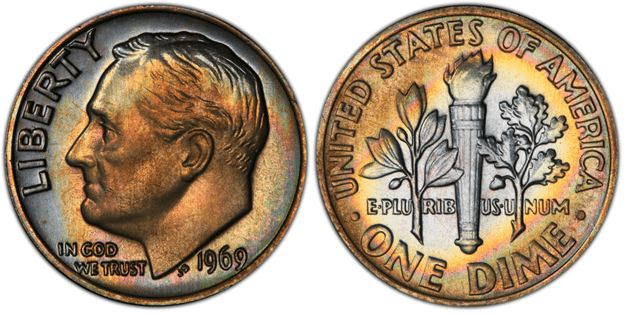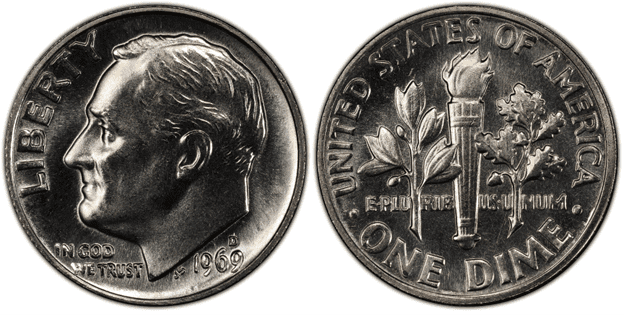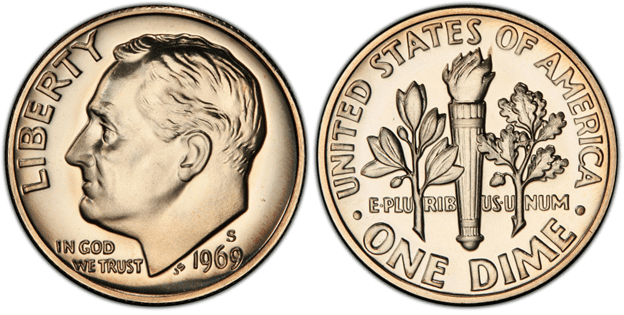What Is A 1969 Dime Made Of?
The Roosevelt Dime has acted as a constant reminder of President Franklin D. Roosevelt’s support for the March of Dimes and his efforts to eradicate polio since it first went into circulation in 1946.
When Congress asked for a new dime to be made in 1945, Chief Engraver John Sinnock came up with the design. In 1946, Sinnock’s design made its debut, replacing the older Winged Liberty Dime.
A bust of President Roosevelt standing to the right dominates the obverse side of the coin. The right field and margin contain the phrases “LIBERTY” and “IN GOD WE TRUST.” At the lower left of Roosevelt’s bust, Sinnock’s initials and the year of mintage are visible. The primary image on the back of the coin features a flame, which stands for liberty.
There is only one group of olive branches on either side of the flame. In the space between each branch and the flame, the words “E PLURIBUS UNUM” are written. Above and below the image are the words “UNITED STATES OF AMERICA” and “ONE DIME.”
The 1964 Roosevelt Dime was the last year that silver was used; the 1968 Roosevelt Dime is made of 75% copper and 25% nickel. This led to a weight of 2.27 grammes and a diameter of 17.9 mm. The edge of the coin has reeding.
Roosevelt dimes have received less attention from collectors than other kinds despite being one of the longest-running circulating U.S. coin series. This might be in part because, other from a few variant coins or a few low-mintage coins, the series lacks a considerable rarity.
Starting at around 350 million for the 1946 P, D, and S coins and increasing to as much as four billion per year in the early 2000s, the mintage of Roosevelt dimes is frequently very high. A reliable circulating currency with a lesser denomination is the Roosevelt dime.
During the American Apollo 11 mission in 1969, Neil Armstrong and Edwin “Buzz” Aldrin made history by being the first humans to set foot on the moon. At Woodstock more than 350,000 rock and roll fans attend and The Beatles record Abbey Road, their final album together.
How Can You Tell If A Dime Is Silver?
As mentioned, dimes minted after 1965 had no precious metal content.
Your dime is almost definitely composed of silver if Lady Liberty is shown on it. Barber dimes and Seated Liberty (minted from 1837 to 1891) are included in this (minted 1892–1916). However, it’s quite rare that you’ll find one of these vintage dimes in your pocket change.
If you’re lucky, you might find a Mercury dime (minted 1916–1945). Although Lady Liberty is depicted wearing a cap with wings, Mercury, a Roman god, has long been thought to be the subject of the painting. The moniker is still used.
A few of the earlier dimes that still include the well-known Franklin D. Roosevelt design will also contain 90% silver, and these are the coins you have the most chance of coming across in pocket change.
Viewing the coin’s edge is the best way to tell if your coins are made of silver. You can be certain that a coin is made of silver if it has a solid silver stripe. The coin is clad if a stripe of copper is visible. The coin may be 40% silver if the silver stripe is more muted and contains very small amounts of copper.
1969 Dime Varieties
1969 Dime With No Mint Mark
Year: 1969
Face Value: $0.10
Composition: 75% Copper and 25% Nickel
Total Weight: 2.27g
Diameter: 17.91mm
Thickness: 1.35mm
Edge: 115 Reeds
Minted in: Philadelphia
Quantity Minted: 145,790,000

photo source: www.pcgs.com
1969 D Dime
Year: 1969
Face Value: $0.10
Composition: 75% Copper and 25% Nickel
Total Weight: 2.27g
Diameter: 17.91mm
Thickness: 1.35mm
Edge: 115 Reeds
Minted in: Denver
Quantity Minted: 563,323,870

photo source: www.pcgs.com
1969 S Dime
Year: 1969
Face Value: $0.10
Composition: 75% Copper and 25% Nickel
Total Weight: 2.27g
Diameter: 17.91mm
Thickness: 1.35mm
Edge: 115 Reeds
Minted in: San Francisco
Quantity Minted: 2,934,631

photo source: www.pcgs.com
List of errors
There are no nationally recognised errors seen in Roosevelt Dimes minted in this year. However, there are a few common errors seen on a coin-by-coin basis, such as:
- Clipped Planchet: Clipped planchet dimes will have a missing part because of a misfeed during the minting process (often elliptical shaped). On a good day, clipped planchet dimes in Mint State condition can sell for $30!
- Blank Planchet: These unusual dimes are known as “blank planchet” because they are never struck with a pattern. These dime errors, which are blank on both sides, typically only reach values of a few dollars.
- Off Center Strike: Coins with off-centre strikes have an improperly aligned obverse or reverse image. These coins frequently have irregular shapes and blank planchet spots. Values range from $10 to $20 per coin, depending on the severity of the off-centre striking.
How Much Is A 1969 Roosevelt Dime Worth Today?
Due to the removal of any silver content, the 1968 Dime’s face value is worth 5 times more than its melt value, which is a mere $0.024. This suggests that 1968 Dimes have more than just their inherent metal value and also have collectable value. Below is a list of expected values for 1968 normal strike dimes in various grades.
| G | VG | F | VF | XF | AU | UNC | |
| 1968-P (No Mint Mark) | – | $0.08 | $0.08 | $0.15 | $0.20 | $1.38 | $1.38 |
| 1968-D | $0.07 | $0.09 | $0.09 | $0.12 | $0.12 | $0.39 | $0.86 |
| 1968-S | – | – | – | – | – | – | £1.58 |
How Does The Grading System Work?
The Sheldon Scale is used by numismatists to provide a numerical value to coins. The Sheldon Scale goes from poor (P-1) to perfect mint state (P-1) (MS-70). Coins were originally evaluated using words to reflect their condition (Good, Fair, Excellent, Etc.). Unfortunately, coin collectors and dealers had different ideas about what each of these terms represent.
Professional numismatists joined together in the 1970s and established CoinGrading standards. These numismatists now assign grades at key places on the seventy-point scale, using the most regularly utilized numeric points in conjunction with the original adjective grade. The following are the most common coin grades:
-
-
- (P-1) Poor – Indistinguishable and probably damaged; if used, must have a date and mintmark; otherwise, rather battered.
- (FR-2) Fair – Nearly smooth, but without the damage that a coin graded Poor often possesses. The coin must have enough detail to be identified.
- (G-4) Fair – Inscriptions have merged into the rims in some areas, and important elements have been mostly erased.
- (VG-8) Very Good- A little weathered, but all of the primary design elements are visible, albeit faintly. There is little if any, central detail left.
- (F-12) Good – The item is very worn, yet the wear is even, and the overall design details stand out clearly. Rims are almost completely isolated from the field.
- (VF-20) Very Fine – Moderately weathered, with some finer features still visible. The motto or all letters of LIBERTY are readable. Both sides of the coin have entire rims that are separated from the field.
- (EF-40) Extremely Fine – Gently used; all gadgets are visible, and the most important ones are bold. The finer details are bold and clear, however, light wear may be seen.
- (AU-50) Uncirculated – Slight evidence of wear on the coin’s design’s high points; may have contact marks; eye appeal should be adequate.
- (AU-58) Uncirculated Choice – Slight traces of wear, no severe contact marks, almost full mint shine, and great eye appeal.
- (MS-60) Mint State Basal – Strictly uncirculated; no indication of wear on the coin’s highest points, but an unsightly coin with reduced luster, visible contact marks, hairlines, and other flaws.
- (MS-63) Mint State Acceptable – Uncirculated, but with contact scratches and nicks, little reduced shine, but otherwise appealing appearance. The strike is weak to average.
- (MS-65) Mint State Choice – Uncirculated with great mint shine, very little contact blemishes, and exceptional eye appeal. The strike is unusually severe.
- (MS-68) Mint State Premium Quality – Uncirculated with superb luster, no obvious contact marks to the naked eye, and exceptional eye appeal. The strike is quick and appealing.
- (MS-69) Almost Perfect Mint State – Uncirculated with perfect brilliance, a sharp and appealing strike, and extremely good eye appeal. A near-perfect coin with minor imperfections in the planchet, strike, and contact markings (seen only under 8x magnification).
- (MS-70) Mint State Perfect – Under 8x magnification, there are no tiny imperfections discernible; the strike is crisp, and the coin is perfectly centered on a beautiful planchet. Rarely seen on a coin, this coin is bright and whole, with original luster and exceptional eye appeal.
-
Where To Buy Or Sell 1969 Dimes?
The majority of 1969 Dimes are sought after by new collectors and those who appreciate the nostalgic character of the mintage year due to their commonality and lack of intrinsic metal value. The best places to buy and sell 1969 dimes are therefore online marketplaces like eBay and Etsy.
On specialised websites like Vcoins., Roosevelt dime specimens that cost more, such as error specimens or examples from a high-quality mintage, can be bought and sold.
FAQs
How much does a 1969 dime weigh?
1969 Dimes weigh 2.27g.
Are dimes without mint marks valuable?
Unless they are known for being a rare error without a mint mark such as some 1968 and 1975 coins, then no, it simply means the coins were minted in Philadelphia.
What year dime is worth millions?
A dime manufactured by the US Barber coinage is the 1894-S Barber dime. Along with the 1804 dollar and the 1913 Liberty Head nickel, it is one of the most coveted and difficult-to-find US coins. One was sold for $1.3 million in 2005, and another was sold in 2007 for $1.9 million.



